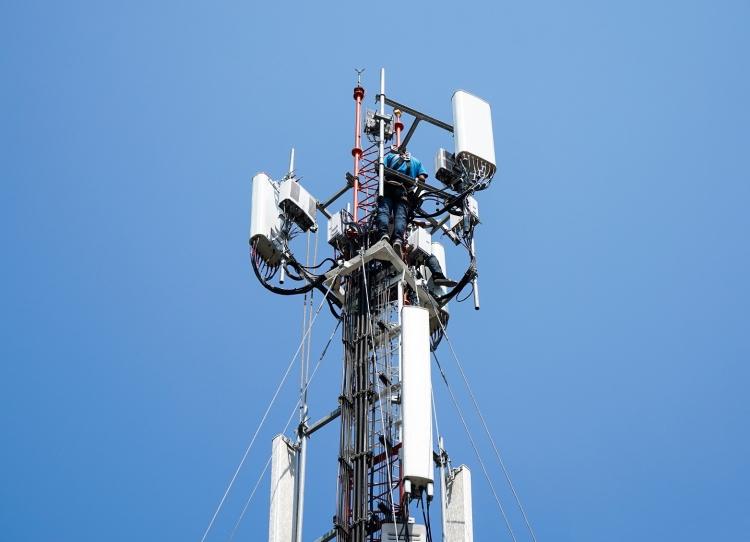You might be reading this blog post on your smartphone, using your mobile broadband network which might be 4G or 5G. But as you read this, have you ever thought that the infrastructure of the mobile broadband you’re using has an impact on the environment?
The environmental impact of different broadband network options is not well understood. The good thing, though, there is widespread interest in providing universal broadband connectivity and improving the environmental sustainability of infrastructure.
We analyzed both aspects simultaneously in our recent research (publication forthcoming) in one of the most dynamic digital markets of South America: Chile. The findings reveal how strategies for achieving universal broadband through 4G and 5G could impact greenhouse gas emissions over the next decade.
Infrastructure operated to provide broadband requires electricity which releases carbon and other emissions into the atmosphere. Our assessment for Chile estimates net emissions for carbon dioxide (CO2), nitrogen oxides, sulfur oxides, and particulate matter (PM10) up to 2030.
Our early results indicate that 5G with a fixed fiber backhaul can be the least demanding energy strategy among the four approaches we looked at (which included 4G with fixed or wireless backhaul and 5G with fixed or wireless backhaul). This is explained by the fact that more sites are required for 4G than 5G to meet the per-user capacity targets, therefore increasing energy demand and atmospheric emissions. Moreover, wireless backhaul requires more power to operate relative to fiber, again increasing atmospheric emissions.
Higher capacity = higher emissions
Findings show a strong trend that higher per-user capacity targets lead to higher carbon emissions because more assets are required to provide greater system capacity, increasing the quantity of operational electricity required to deliver universal broadband.
In addition to producing carbon emissions, energy production also releases numerous undesirable pollutants into the atmosphere, such as nitrogen oxides, sulfur dioxides, and particulate matter. See figure 1 below which visualizes the corresponding carbon emissions produced from using on-grid power in Chile, based on the current energy generation mix in operation.
Figure 1. Assessment of carbon emissions for universal broadband options in Chile

The research also estimates the potential quantity of nitrogen oxides, sulfur oxides, and particulate matter emissions across the various scenarios, capacity targets, and technology strategies. In line with the CO2 emissions forecast, 5G with a fiber backhaul is the most climate-friendly technology. Moreover, 5G-related emissions increase less significantly than 4G when extra capacity per user is considered, thanks to the spectral efficiency improvements between these generations when the capacity target per user is held constant. For instance, nitrogen oxide emissions from 5 to 20 Mbps increase by 32 percent in the case of 5G with fiber backhaul, while it rises by 151 percent in the case of 4G with wireless backhaul.
According to estimates by GSMA, the number of cellular sites using off-grid diesel generators in Chile is approximately 2 percent, raising concerns around the environmental sustainability of such sites. Given the existing commitment in Chile regarding renewable energy sources, figure 2 explores the sustainability benefits from shifting cellular sites from diesel generators to renewable sources, such as photovoltaic and wind power systems. The results are reported for a capacity per user target of about 10 Mbps. Implementing renewable energy power for all cellular sites using diesel generators leads to CO2 emission savings of up to 19 percent, for example, when using 5G with a wireless backhaul link.
Figure 2. Assessment of off-grid renewable power strategies for universal broadband options in Chile

Diesel vs. renewable energy generators
Chile emits approximately 86 megatons of CO2 annually, so the estimated emissions here—across different scenarios—are well below 1 percent of annual emissions. This shows how the impact on emissions of a cellular broadband network is relatively limited compared to other infrastructure sectors. GHG emissions depend on the share of mobile sites using diesel generators. Switching from diesel to renewable sources reduces CO2 and GHG emissions and has a positive impact on the environment.
So what can this mean for the future of green infrastructure? While the Chile case study gives us a specific example of how broadband can impact emissions there, these impacts could be much larger in countries with a larger share of off-grid mobile towers using diesel generators. At the same time, providing universal connectivity can be an important part of our toolkit to help us reduce emissions around the planet.
We look forward to continuing our research to better understand how more environmentally-friendly broadband infrastructure can be part of long-term policy and planning to support climate change mitigation and adaptation strategies.


